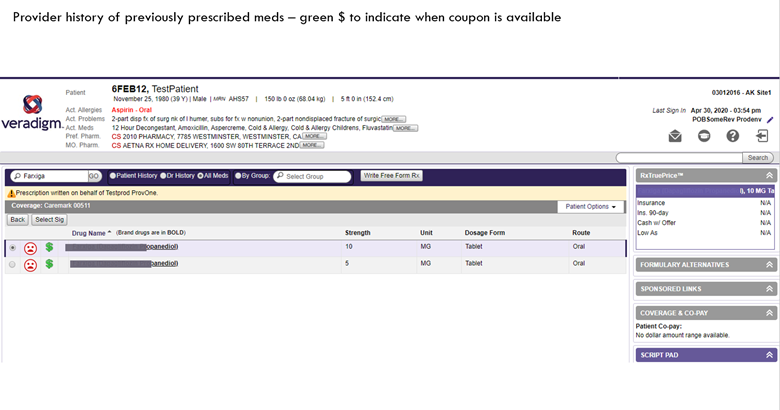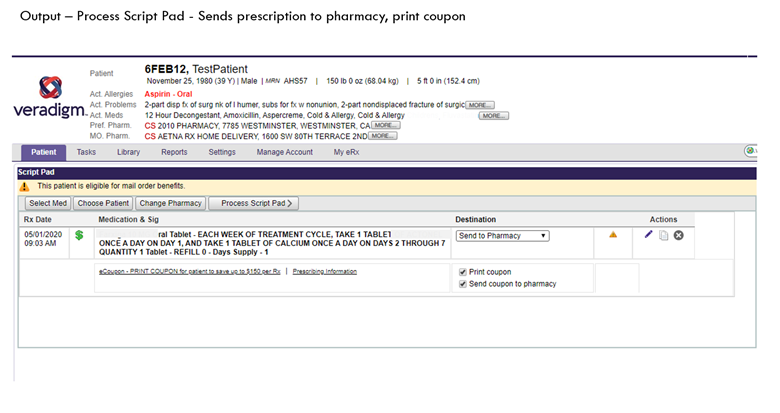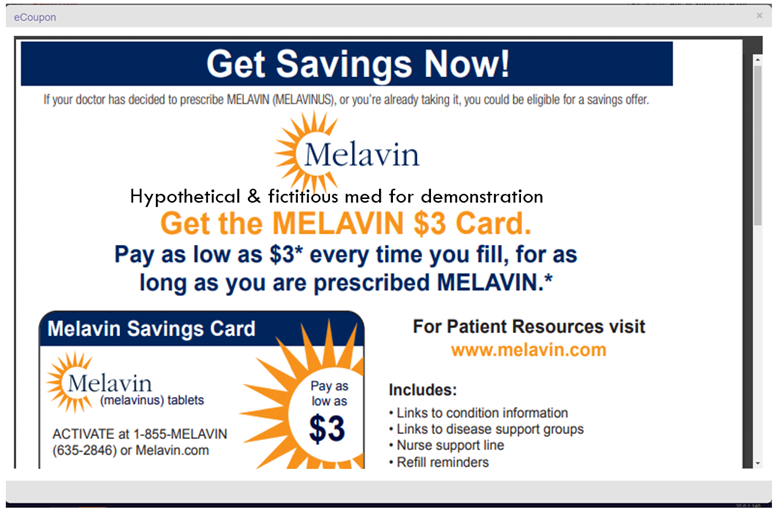Reduce Medication Non-Adherence and Improve Prescription Affordability with eCoupons

Medication non-adherence is thought to affect more than 50% of all patients.1 Non-adherence is especially common among patients with chronic diseases, affecting as many as 50% of patients with chronic conditions such as diabetes, hypertension, or chronic cardiovascular conditions, even for those with good health insurance and drug benefits.2, 3 One study found that medication nonadherence was the most common reason for inadequate control of coronary heart disease, diabetes mellitus, and hypertension, some of the most common conditions in older adults.3
Nearly half of adults in the US have one or more chronic conditions.4 Medication can be a cost-effective treatment option for chronic conditions, but medications can only improve health outcomes if patients take them as directed. The World Health Organization estimates that, in developed countries, patients with chronic conditions have only a 50% rate of medication adherence for their long-term therapy.5
The impacts of medication non-adherence
Medication non-adherence has significant impacts on both patients and the healthcare system in the United States. Research has shown that medication non-adherence causes:2, 4, 6, 7
- Increased risk of disease progression, including increased mortality
- Increased risk of hospitalization for patients with a wide variety of common chronic conditions, such as diabetes, heart failure, and coronary artery disease
- Increased costs to payers
- At least 100,000 to 125,000 preventable deaths every year
Medication non-adherence is also thought to cause a total of $100 billion to $300 billion in preventable medical costs every year, or 3% to 10% of total US health care costs.2, 4, 8
High prescription costs: the primary cause of medication non-adherence
According to the Centers for Disease Control and Prevention (CDC), US spending on prescription medication is greater than $320 billion a year.9 Americans spend an average of about $1200 per person per year on prescription medications, more than anyone else in the world.10
Research has consistently shown that high cost is the primary reason for medication non-adherence.7, 11 According to a recent poll, the high cost of prescription medication is the primary cause of non-adherence for 67% of patients.9 Among the most economically vulnerable patients (those with incomes of less than $25,000 a year), 95% said they did not fill or pick up their prescriptions due to cost and 12% said cost caused them to stop taking their medication before their provider recommended ending treatment.9
Patients struggling with medication costs will skip doses of their medications, reduce doses, or let their prescriptions go unfilled. Researchers have even found that patients will do without basic needs such as food, heat, and other necessities in order to afford their medications.12 For example, a recent survey from the American Diabetes Association found that more than one in four diabetes patients said they had used less insulin than prescribed due to costs. Underuse of insulin was associated with a three-fold increase in high HbA1c compared with patients who didn’t underutilize medications, potentially resulting in additional complications and further increasing treatment costs.13
Despite the fact that cost is a major factor in medication adherence, only 16% of low-income individuals use cost-savings measures such as drug company rebates or coupons to help with their medication costs.9 eCoupons are available in Veradigm’s electronic prescribing software, ePrescribe. Veradigm ePrescribe automatically delivers eCoupon information after the medication is selected for eligible medications directly to your electronic prescribing workflow, helping you to help your patients reduce out-of-pocket costs.14 Read on to learn how to access eCoupons and prescription price information for your patients.
Using eCoupons in Veradigm ePrescribe
Veradigm ePrescribe is a comprehensive solution for electronic prescribing used by over 140,000 prescribers for hundreds of millions of transactions every year. eCoupons are automatically available to all providers as part of their electronic prescribing workflow.14, 15 Since June, 2018, eCoupon distribution has increased fifteen fold in ePrescribe.15
In ePrescribe, prescribers can start by viewing the patient’s history of previously prescribed medications. Then, the provider can select a medication by clicking the circle to the left of the medication name. A green dollar sign indicates when a coupon may be available for that medication.
Next, a prescriber can click Select Sig to add prescription details:

If an eCoupon is available for the medication, it will be displayed on the medication Destination screen. The provider has the ability to view the coupon for details by clicking on the eCoupon link. As the prescription is finalized, the prescriber can choose the coupon’s destination as well: to print it or to send it to the pharmacy electronically. This is specified by selecting one or both of the checkboxes for Print coupon or Send coupon to pharmacy.* (Default settings can be established for prescriber workflow preference.)
Clicking Process Script Pad will output the prescription to the pharmacy along with the coupon.

Clicking on the eCoupon link will open a screen showing the coupon details. The provider is also able to Print from here as well.

eCoupons may help improve medication adherence and patient outcomes
Incorporating price transparency into your medication conversations can help grow trust between you and your patients. eCoupons are one way to do this. They can help make medications more affordable for your patients. More affordable medications can help to increase your patients’ medication adherence, which can help improve their health outcomes.14
To learn more about eCoupon functionality in Veradigm ePrescribe, click here.
*Note: Eligibility restrictions apply and eCoupons should not be provided to any patient who utilizes any Federal or state health care program to pay for his or her medications, including but not limited to Medicare or Medicaid.
References:
- Bresnick J. Medication Non-Adherence Brings Millions in Avoidable Costs. Health IT Analytics. Updated February 13, 2015. Accessed May 20, 2021, https://healthitanalytics.com/news/medication-non-adherence-brings-millions-in-avoidable-costs.
- Kleinsinger F, MD. The Unmet Challenge of Medication Nonadherence. Perm J 2018 22:18-33. doi:10.7812/TPP/18-033.
- Marcum ZA, Zheng Y, Perera S, et al. Prevalence and Correlates of Self-Reported Medication NonAdherence among Older Adults with Coronary Heart Disease, Diabetes Mellitus, and/or Hypertension. Res Social Adm Pharm. 2013 9(6)doi:10.1016/j.sapharm.2012.12.002.
- Iuga AO, McGuire MJ. Adherence and health care costs. Risk Management and Healthcare Policy. February 24, 2014 7:35-44.
- Sabaté E, World Health Organization. Adherence to Long-Term Therapies: Evidence for action. 2003. Accessed May 18, 2021. https://www.who.int/chp/knowledge/publications/adherence_full_report.pdf.
- PAN Foundation. Issue Brief No. 13: Medication Adherence. 2020. April 2020. https://www.panfoundation.org/app/uploads/2020/05/Issue-Brief-13_Medication-Adherence.pdf.
- Lee S, Jiang L, Dowdy D, Hong AY, Ory MG. Attitudes, Beliefs, and Cost-Related Medication Nonadherence Among Adults Aged 65 or Older With Chronic Diseases. Preventing Chronic Disease. December 6, 2018 15:180190. doi:http://dx.doi.org/10.5888/pcd15.180190.
- Cutler RL, Fernandez-Llimos F, Frommer M, Benrimoj C, Garcia-Cardenas V. Economic impact of medication nonadherence by disease groups: a systematic review. BMJ Open. January 21, 2018 8:e016982. doi:10.1136/bmjopen-2017-016982.
- Bresnick J. Cost is a Primary Driver of Medication Non-Adherence Rates. Health IT Analytics. Updated September 11, 2017. Accessed May 20, 2021, https://healthitanalytics.com/news/cost-is-a-primary-driver-of-medication-non-adherence-rates.
- Langreth R. Quick Take: Drug Prices. Bloomberg. Updated September 16, 2020. Accessed May 18, 2021, https://www.bloomberg.com/quicktake/drug-prices.
- McHorney CA, Spain CV. Frequency of and reasons for medication nonfulfillment and non-persistence among American adults with chronic disease in 2008. Health Expectations. 2010 14:307-320. doi:10.1111/j.1369-7625.2010.00619.x.
- Harrold LR, Briesacher BA, Peterson D, et al. Cost-Related Medication Nonadherence in Older Rheumatoid Arthritis Patients. J Rheumatol. February 2013 40(2)doi:10.3899/jrheum.120441.
- Hamm N. How High Drug Prices Affect Patients. Managed Healthcare Executive. Updated May 6, 2019. Accessed May 18, 2021, https://www.managedhealthcareexecutive.com/view/how-high-drug-prices-affect-patients.
- ePrescribe–Automate and Empower Your Prescribing Success. Veradigm. Accessed May 19, 2021, https://veradigm.com/eprescribe/.
- Veradigm ePrescribe Integrated - Your Ideal Solution for Advanced, “Plug-and-Play” e-Prescribing. Veradigm. Accessed May20, 2021, https://veradigm.com/eprescribe-software/?s=ePrescribe#1.